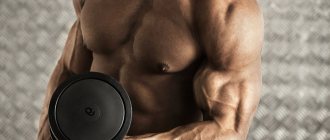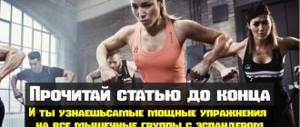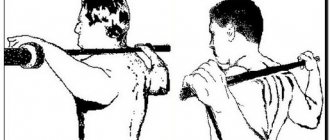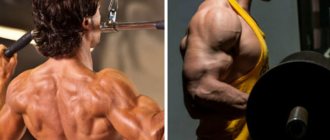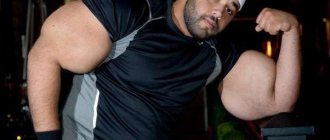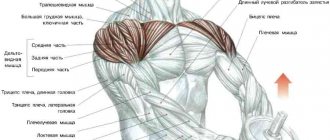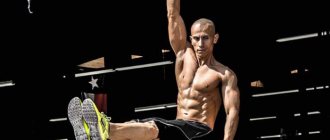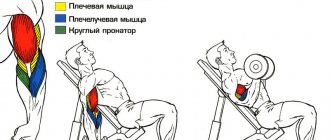Toned muscles of the shoulders and arms not only form a beautiful silhouette, but also make the body more proportional.
With basic loads on the back, they are not properly pumped; special training is required for effective loads.
In this article we will talk about the most popular exercises, technical aspects and nuances of pumping.
To comprehensively train the shoulder muscles, you should perform basic exercises that work the entire deltoid muscles.
If the development of any of the bundles lags, you should do local work using isolating exercises.
Rules for pumping the anterior and posterior deltoid muscles
The shoulders are a special muscle complex that is responsible for many movements. The muscles near the shoulder joint are called the deltoids/deltoid muscles. According to the description of human physiology, they consist of 3 heads/bundles: anterior, middle and posterior.
The vast majority of the time, all deltoid muscles work in parallel - 3 heads are involved at once (for example, during a dumbbell bench press). But when performing certain movements, you can isolate a specific beam:
- Anterior – responds to shoulder flexion (lifting weight in front of the body).
- The middle one is responsible for flexing the shoulders (raising the arms to the sides).
- Rear - makes it possible to extend the shoulders in the position of the hands behind the body (pulling the dumbbells back when tilting the body).
How to pump up your arms and shoulders
You can often see men training their chest and biceps in the gym. And for some reason they don’t spend as much time on the deltoid muscles. But they are the ones who make our shoulder girdle wide.
Before performing any exercise, you need to warm up.
Today in class:
1. Basic shoulder exercises
- Seated vertical press
- Shoulder abduction from the body
2. Rear deltoid
- Shoulder extension
3. Biceps
- Standing Forearm Curl with Dumbbells
4. Triceps
- French press
- Adjustable Row Forearm Extension
Important! To avoid getting sick during training, don’t forget to eat an hour and a half before training.
Basic shoulder exercises
Seated vertical press
Three points of support: feet, pelvis and pressed shoulder blades. The abs must be tensed so that there is no bending in the lumbar region. Your arms should be lowered until they are parallel to the floor, but not lower, so as not to injure the ligaments of the shoulder joint. When raising your arms upward, the elbow joints are not fully straightened so that the load remains on the anterior deltoid muscles. Try to maintain a 90 degree angle at the elbow joint.
This is an easy exercise because in a sitting position the body is half isolated. This exercise worked the anterior delta, which is responsible for shoulder extension. You can work on the front deltoid by lifting a weight plate or dumbbells in front of you.
If you are not a beginner, you have enough power in the muscular corset of the body, you can work while standing with a barbell or dumbbells.
Shoulder abduction from the body
This exercise works the middle delta, which is responsible for shoulder abduction. One of the main tasks is not to relax your arms at the lowest point, you need to keep them in constant tension and try not to raise your arms above parallel with the floor, so as not to engage the trapezius delta. Girls do not need to pump up this muscle, but for guys it is better to consult with their trainer so that he can test the mobility of the shoulder joint.
Shoulders are lowered, try to raise your elbow higher than your hand, the little finger bone looks slightly higher than the index finger bone. Remember that your arms should not be relaxed at the bottom. Try not to raise your shoulders. The angle between the body and arms should not reach 90 degrees, that is, it will be slightly below parallel with the floor. If you lift it higher, the movement of the shoulder blades will begin and the trapezius muscle will actively engage. The working amplitude is about 80 degrees relative to the body.
Since the middle deltoid is responsible for shoulder abduction, there are many exercises where it performs its function.
Rear delta
Shoulder extension
The exercise is aimed at the rear delta. We take a fitness band and first set the difficulty to the distance of arm extension. The greater the distance between the hands to grip the elastic band, the easier it is to move them away. When performing the exercise, you need to try not to squeeze your shoulder blades. They should remain in one place while you move your arms to the sides. Exhale while abducting your arms. To relax - inhale. When you return to the starting position, try not to relax the elastic band.
The same exercise can be done while sitting with dumbbells. Place your feet slightly in front, lean forward with a straight back and begin to do the same movement in your shoulders. Try not to raise your head so that it is an extension of the spine.
Guys can do a more strength exercise using the biceps and back muscles. These are all kinds of traction, where the shoulder will be at an angle of 90 degrees relative to the body.
Biceps
The biceps is the biceps brachii muscle. The simplest exercises in terms of technique are aimed specifically at the biceps, because one joint and one axis of rotation are involved.
Standing Forearm Curl with Dumbbells
Feet shoulder-width apart, hands on the outer thighs, palms facing forward. Begin to bend your arms at the elbow joint and try not to move your shoulders. The arms are raised slightly above an angle of 90 degrees and not lowered all the way so that constant muscle tension remains. Do not raise your arms all the way so that the load on your biceps remains minimal.
You can change the position of your hands and engage the brachioradialis muscle. Weight options for this exercise can be a barbell, adjustable rows, or TRX loops. Since when performing exercises on the back, the biceps is also involved, girls do not need to perform many separate exercises on this muscle, so as not to make their shoulder corset wide. Guys should not forget about isolating biceps exercises on special machines.
Triceps
French press
For girls, it is suitable to perform the exercise lying on a mat, for guys - on a bench and with heavy weights.
Raise your arms slightly bent at the elbows in front of you, place them perpendicular to the floor. The work will be performed by only one joint - the elbow. Bend your arm to 90 degrees, and then straighten it not completely, not until the joint is fully engaged.
Option for guys: to load the triceps more, you can extend your arms even further and lower the dumbbells behind your head.
Adjustable Row Forearm Extension
Feet shoulder-width apart, body slightly forward, pelvis slightly back. Lower your arms and fix your shoulder. Work with one shoulder joint, bend your arm at the elbow to 90 degrees and straighten it again. When exerting force, exhale; when relaxing, inhale.
You can also do push-ups with a narrow grip, on parallel bars, or use triceps exercise machines to work your triceps muscles.
In the next issue we will look at how to work on your abs.
How to pump up your back and pectoral muscles - we tell you here.
You can see how to pump up your legs and buttocks in this lesson.
Find out how to choose the right training uniform here.
How to eat during training, read here.
Learn how to properly warm up and cool down with this lesson.
We would like to thank the Premier Fitness fitness club for their assistance in organizing and conducting the shooting.
Music used in the video: Ours Samplus - Flying Ship
Follow the news in the world of fitness on Slenergy!
All basic and isolation exercises with dumbbells and without equipment for the deltoids and arms
- military press. Suitable for pumping the front deltas, partially connecting the middle beam and core muscles. The grip width of the bar should be average - place your hands slightly wider than your shoulders;
Note! If you take the bar wide, part of the force load will shift to the pectoral muscles; if you take it narrow, you may overload the triceps.
As you press, gradually lift the barbell onto your even arms and lower it no lower than your jawline. This technique will prevent overloading the shoulder joint. Do 2-3 sets of 8-10 repetitions;
- barbell pull to the chin. Trains the trapezius muscles, as well as the anterior and middle deltoids (the wider the grip, the more the deltoid muscles are loaded).
While performing the exercise, lift the barbell to chin level, moving with your elbows (your back should remain straight). Perform the row smoothly, focusing on the shoulder muscles. At the top, your elbows should be higher than shoulder level; stay at this point for a couple of seconds. Then slowly lower the barbell to the starting position. Do 3 sets of 8-10 reps;
- dumbbell lateral raises. Suitable for isolated work on the middle head of the deltas. Lean your body forward, keeping your shoulders low enough. When gripping dumbbells and performing the exercise, your thumbs should point down. Raise the dumbbells to shoulder level and lower them slowly. Perform 3-4 sets of 10-12 repetitions;
Important ! Perform the exercise as smoothly as possible, without sudden jerks - this will help avoid injury.
- dumbbell press in a sitting/standing position. Take dumbbells and lift them above your head, then slowly lower them to ear level (the angle formed between your shoulders and forearms should be straight). Frequency of repetition: 3 sets of 10 times;
Remember ! Do not lower the weight below this level, otherwise the negative load on the joint will increase.
- raising your arms to the sides with an elastic band. This is the perfect exercise for pumping up your rear deltoids. Tilt your torso down, keeping your arms down and your palms facing inward. Slowly raise your arms through the sides and hold them at the top point until a characteristic “burning” sensation occurs in the muscles. Do 10-12 lifts;
Important ! Concentrate on the degree of muscle tension, not on the number of repetitions.
- door press. Refers to isometric exercises that are aimed at static tension in the muscles. Stand upright in a doorway with reasonably strong jambs. Then raise your arms up and rest your palms on the upper slope. When your hands are sufficiently fixed, you can begin to push your body forward. This exercise should be performed for time, not for the number of repetitions. Perform the described actions for 30-40 seconds, then take a break and repeat the exercise.
Where to start training and how to distribute the load?
You need to start training with special attention to warming up, since the elbow and shoulder joints are among the risk areas. That is, the most traumatic, susceptible to stretching and rupture of ligamentous tissues. The shoulder joints are generally one of the most complex and unstable in the human body. Following the general physical exercises from the usual morning exercises, which will help warm up these joints, do the following warm-up exercises:
- push-ups from the floor (elbows are not apart, but close to the sides, to engage the triceps);
- Bench press with low load (barbell with 30% of working weight).
This will not only help warm up the joints and increase their elasticity, but will also drive blood into the muscles of the upper body, increasing their saturation with oxygen, nutrients and energy.
There is a reasonable opinion that it will be better if the training on this day begins not with the shoulders, but with the muscles of the arms. The fact is that in almost all basic exercises for the shoulder muscles, the arm muscles are always involved. Therefore, there is a high probability of “hammering” them prematurely and not purposefully, preventing full loading in the actual arm exercises.
In this case, the forearms, if you are specifically working on them, should be left for the final part of the lesson. Arm training should start with exercises for the biceps, and continue with working on the shoulders. However, some athletes claim that it is best to pump your shoulders in front of your arms, and this opinion also has a right to exist. Everyone determines for themselves by experience which option is most effective for them personally.
Effective training for working out the delta
Pumping the deltoids should be combined with a load on the pectoral muscles. If you train them separately, the total load on the shoulder joints will occur at least 4 times a week, which can cause overtraining. If you haven't yet decided how to train to build up your shoulder muscles, use a rough plan.
The program for 2 training days a week will look like this.
Day 1:
- Warm-up: cardio (running, jumping rope) – 15-20 minutes.
- Dumbbell press: 3 sets of 12 reps.
- Dumbbell flyes: 3 sets of 8 repetitions.
- Bent over flyes: 3-4 sets of 10 reps.
Day 2:
- Warm-up: cardio – 15-20 minutes.
- Arnold Press: 3 sets of 8 reps.
- Barbell chin raises: 3-4 sets of 10 reps.
- Bent-over arm raises: 4 sets of 10 repetitions.
Triset with dumbbells on a bench
For this triset you need a bench and two pairs of dumbbells: lighter and heavier. Lighter for shoulder exercises, heavier for biceps and triceps. Choose weights that you can do 8-16 reps with (try it during your warm-up if you're not sure).
A1 Seated biceps curl
A2 Lying triceps extension (French press with dumbbells)
A3 Dumbbell fly, lying on your side (repeat for each arm)
To avoid falling off the bench during the fly, hook one foot onto the bench and place your bottom hand on the floor (the edge of the bench will be under your armpit).
Tips on what to do if muscles don't grow
Quite often, problems with pumping muscles in the shoulder area arise due to incorrect exercise technique. The most popular errors include:
- High weight and low reps. The optimal number of repetitions is considered to be 8 or more times - the deltoid muscles love high-repetition training.
- Equal attention to all muscle bundles. Often, individual muscles may develop unevenly (for example, the anterior bundle is used in many basic exercises, while the posterior bundle is in most cases poorly developed). To prevent this, increase the number of sets for the “lagging” muscle and decrease the number for the dominant one.
- Frequent training. Muscles cannot actively develop in a state of overtraining, so do not forget about recovery (train the deltoid muscles no more than 2 times a week).
- Poor progress when following all the rules of effective training. Working on muscles happens not only in the gym, but also in the kitchen. Try to eat a balanced diet - consume at least 2 grams of protein per 1 kg of your weight.
Pro Tips
Yu. Spasokukotsky, professional bodybuilder, personal trainer
A large number of athletes believe that they train their deltoids correctly and comprehensively. In fact, there is a constant overload of the front deltoid muscles with complete or partial neglect of the middle and rear deltoid muscles. Errors in the technical plan of exercises, as well as irrational selection of training exercises, can completely stop progress.
The optimal program, which allows you to quickly strengthen the shoulder muscles, should be based on different variations of flyes and rows while limiting the number of bench presses while sitting or standing.
B.-J. Gadur, American fitness trainer, author of an individual training system
Most often, I choose basic exercises that involve several muscle groups. For example, when doing push-ups on 2 dumbbells placed side by side, you can simultaneously pump up the chest muscles, triceps and shoulder muscles.
For an exercise to be 100% effective, you must get the maximum benefit out of each repetition. To do this, you should concentrate on the work of the muscles, their contractions, and measured breathing.
Will it be effective to train your shoulders and arms in one day?
The muscle groups mentioned in the introduction are located next to each other, and the blood flow during the work of the shoulders and arms will be carried out to the upper body, with an even saturation of the deltoids, trapezius, biceps, triceps and forearms. Joint training for arms and shoulders allows you to effectively hammer both muscle groups within one hour of training.
This program is certainly effective, but it makes sense to change it from time to time for another, with a new combination of muscle groups. After all, to ensure progressive progress, you need to “surprise” your body from time to time by “throwing” at it combinations of exercises to which it has not adapted.
Main conclusions
Special training will help pump up the deltoid muscles of the shoulders as efficiently and quickly as possible:
- Select exercises based on the degree of development of each deltoid muscle bundle (as a rule, more attention should be paid to the posterior bundle).
- Combine basic and isolated exercises for high-quality muscle development.
- The optimal number of workouts is considered to be 2 delta workouts per week.
Before starting training, be sure to consult with a qualified trainer!
Effective training for shoulders and arms
Working the deltoid muscles, as a rule, also involves the trapezius muscles. Therefore, they also require close attention. To work your trapezius, you should perform shrugs with weights such as dumbbells. It is necessary to constantly monitor your own progress. When it slows down or a raft state sets in, it’s time to start high-volume methods that involve training in a system of drop sets, forced repetitions, and supersets. This step will allow you not to stop muscle growth and continue to progress.
